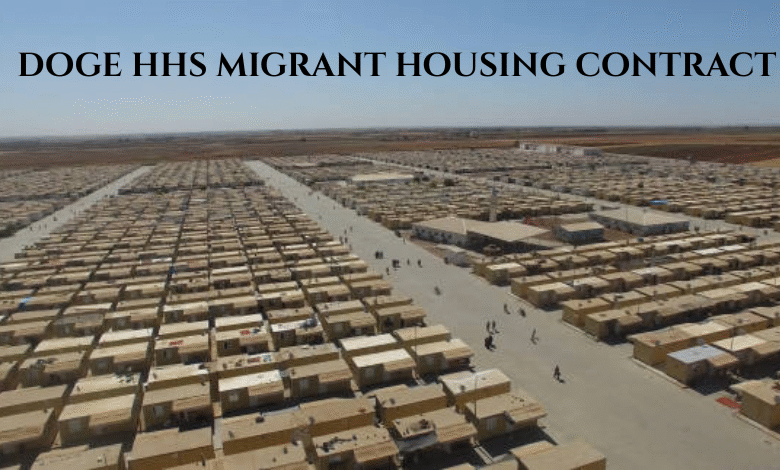Doge HHs Migrant Housing Contract

Imagine shelling out millions of dollars every month for a building that’s just gathering dust. That’s exactly what was happening with a migrant housing contract in Texas until the Department of Government Efficiency (DOGE) stepped in and put an end to it. This isn’t just a story about one contract it’s a window into how government agencies like the Department of Health and Human Services (HHS) manage migrant housing and how DOGE is shaking things up to save taxpayer money.
In this article, we’ll unpack everything you need to know about the “DOGE HHS migrant housing contract” saga. From what DOGE is all about, to why this particular deal went south, to the jaw-dropping savings that came out of scrapping it, we’ve got it all covered. Expect clear explanations, some handy tables, and even an FAQ section to answer those burning questions you might have. Let’s dive in!
Introduction: A Costly Contract Meets Its End
Picture this: it’s 2025, and the U.S. government is footing a bill of $18 million per month for a migrant housing facility in Texas that’s sitting mostly empty. This wasn’t a small oversight it was a sole-source contract with a nonprofit called Family Endeavors, set up by HHS to house unaccompanied migrant kids during border surges. But when the crowds didn’t show up, the facility stayed vacant, and the payments kept flowing.
That’s when DOGE, the new kid on the government block, swooped in. Tasked with sniffing out waste, DOGE zeroed in on this deal, flagged it as a money pit, and got it terminated. The result? Over $215 million saved every year. This story isn’t just about numbers it’s about accountability, efficiency, and what happens when government spending gets a hard look.
Here’s what we’ll explore:
-
What DOGE is and why it exists
-
How HHS handles migrant housing
-
The nitty-gritty of this controversial contract
-
DOGE’s big move to shut it down
-
What it all means for taxpayers and migrant policies
By the end, you’ll see why this case matters and what it could signal for the future of government operations.
What’s the Deal with DOGE?
The Department of Government Efficiency (DOGE) isn’t your typical federal agency. Launched during President Donald Trump’s second term, it’s a bold experiment in tackling government waste head-on. Think of it as the government’s own efficiency guru, with a mission to cut costs, streamline operations, and make sure every dollar counts.
DOGE’s Mission in a Nutshell
-
Hunting Down Waste: DOGE digs into contracts and programs to find where money’s being spent with little return.
-
Streamlining Staff: It’s taken a hard look at federal jobs, trimming positions that overlap or aren’t pulling their weight.
-
Tech-Savvy Solutions: From data crunching to process automation, DOGE uses modern tools to boost performance.
Led initially by Elon Musk yes, that Elon Musk DOGE has made waves since day one. It’s not afraid to ruffle feathers, whether that’s by slashing budgets or rethinking how agencies operate. In the migrant housing contract case, DOGE showed its teeth, proving it’s more than just talk.
Why DOGE Matters
Government spending has long been a hot-button issue. With taxpayers footing the bill, there’s pressure to make sure funds aren’t frittered away. DOGE’s role is to bridge that gap, delivering results that hit both the budget and public trust. Love it or hate it, it’s changing the game.
HHS and Migrant Housing: The Backstory
The Department of Health and Human Services (HHS) isn’t new to the scene. It’s the agency tasked with keeping Americans healthy and supported, from Medicare to child welfare. One of its trickier jobs? Handling housing for unaccompanied migrant children kids who cross the border without parents or guardians.
How HHS Manages Migrant Housing
-
The Players: Through its Office of Refugee Resettlement (ORR), HHS partners with nonprofits and private groups to run shelters.
-
The Goal: Provide safe, temporary housing for migrant kids until they’re reunited with family or placed in foster care.
-
The Challenge: Migration flows are unpredictable sometimes there’s a flood of arrivals, other times it’s a trickle.
HHS has a legal duty to care for these kids, which means having facilities ready when needed. That’s where contracts come in. They lock in deals with organizations to operate shelters, often at a fixed cost, whether the beds are full or not. It’s a system built for flexibility but one that can backfire when demand drops.
The Migrant Housing Contract: What Went Wrong?
Let’s zoom in on the contract that sparked all the fuss. Back in March 2021, HHS signed a deal with Family Endeavors, a Texas nonprofit, to run an overflow housing facility in Pecos, Texas. The idea was simple: have extra space ready for unaccompanied migrant kids during peak migration. But the execution? Not so smooth.
Breaking Down the Contract
-
Who: Family Endeavors, a nonprofit based in Texas
-
What: A sole-source contract (no bidding war, just a straight deal)
-
Where: Pecos, Texas
-
How Much: $18 million a month, totaling $216 million a year
-
Why: To house migrant kids when regular shelters were full
On paper, it made sense. Border surges can overwhelm standard facilities, so having a backup was smart. But here’s where it went off the rails.
The Big Problems
-
Empty Beds: By 2024, the facility was barely used. National licensed facility occupancy dipped below 20%, meaning most of those beds were collecting dust.
-
No Competition: Sole-source contracts skip the bidding process, which can lead to higher costs and less accountability. Critics wondered if taxpayers were overpaying.
-
Nonprofit Windfall: Family Endeavors saw its cash and investments skyrocket from $8.3 million in 2020 to $520.4 million by 2023. Coincidence? Maybe, but it raised eyebrows.
This wasn’t just a minor hiccup. The government was pouring millions into a ghost town of a facility, and the public started asking questions. Why keep paying for something that wasn’t delivering?
DOGE Steps In: The Termination Timeline
Enter DOGE, stage left. By early 2025, the department had its sights on this contract. With a mandate to root out waste, DOGE didn’t mess around. Here’s how it went down:
What DOGE Did
-
Digging In: DOGE reviewed the contract’s fine print costs, terms, the works.
-
Checking the Numbers: They crunched occupancy data and saw the facility was a money sink.
-
Making the Call: DOGE told HHS to pull the plug, and HHS listened.
The result? The contract was axed, effective immediately. That $18 million monthly bill vanished, saving over $215 million a year. It was a clean, decisive win for DOGE’s efficiency crusade.
A Bigger Picture
This wasn’t a one-off. DOGE has been poking around other agencies too think IRS, FDA, even HUD looking for similar fat to trim. The migrant housing contract just happened to be a glaring example that caught the spotlight.
The Fallout: Savings, Scrutiny, and What’s Next
So, what happened after the contract got the boot? Let’s break it down.
Money Saved
-
Monthly: $18 million off the books
-
Yearly: A cool $215 million+ back in taxpayers’ pockets
That’s not chump change. It’s the kind of cash that could fund schools, roads, or healthcare instead of an empty building.
Ripple Effects
-
Tighter Oversight: Other contracts are now under the microscope. If it happened once, could it happen again?
-
Policy Questions: Some worry about future migrant housing shortages. What if there’s a surge and no overflow space?
-
Public Reaction: Taxpayers cheered the savings, but immigration advocates raised concerns about readiness.
HHS and DOGE have countered that the decision was data-driven the facility wasn’t needed now. If demand spikes, they say, they’ll adapt. Still, it’s a balancing act between cost-cutting and preparedness.
Tables to Make It Clear
Let’s put some of this into perspective with a couple of tables.
Table 1: Contract Costs at a Glance
|
Category |
Details |
|---|---|
|
Monthly Cost |
$18 million |
|
Annual Cost |
$216 million |
|
Savings After Termination |
$215 million+ |
|
Occupancy Rate |
Below 20% |
|
Contract Duration |
2021–2025 (terminated early) |
Table 2: Timeline of Events
|
Date |
Event |
|---|---|
|
March 2021 |
HHS signs contract with Family Endeavors |
| 2020–2023 |
Nonprofit’s assets jump from $8.3M to $520M |
| 2024 |
Facility sits mostly empty |
|
Early 2025 |
DOGE reviews and terminates contract |
|
Post-Termination |
$215M+ saved annually |
These visuals cut through the noise, showing the stakes and the timeline in black and white.
Why This Matters to You
You might be wondering, “Okay, but how does this affect me?” Fair question. If you’re a taxpayer, this is your money at work or, in this case, not at work until DOGE stepped in. It’s a real-world example of government accountability in action. Plus, it touches on bigger issues like immigration policy, federal spending, and how we balance efficiency with human needs.
Beyond the Dollars
-
Trust in Government: Moves like this can rebuild faith that agencies are watching the bottom line.
-
Migrant Care: It forces a rethink of how we house vulnerable kids without breaking the bank.
-
Future Cuts: If DOGE keeps this up, more savings could be on the horizon but at what cost?
This story’s got layers, and we’re just getting started peeling them back.
Diving Deeper: The Context of Migrant Housing
To really get this, let’s zoom out a bit. Migrant housing isn’t a new problem. The U.S. has been wrestling with it for decades, especially when it comes to unaccompanied kids. These children often fleeing violence or poverty need somewhere safe to stay while their cases are sorted out. That’s where HHS comes in, and why contracts like the one in Pecos exist.
The Migration Rollercoaster
Migration doesn’t follow a schedule. Some years, like 2021, see huge spikes at the border. Other times, like 2024, things quiet down. The trick is predicting demand and scaling up or down without wasting resources. The Pecos facility was built for the peaks, but when the valleys hit, it became a liability.
Past Controversies
This isn’t the first time migrant housing has made headlines. Remember the “kids in cages” uproar during the Trump years? Or the debates over private contractors profiting off government deals? The Pecos contract fits into that messy history a mix of good intentions, logistical headaches, and financial missteps.
DOGE’s Playbook: How They Pulled It Off
Let’s give credit where it’s due DOGE didn’t just stumble into this win. They’ve got a method, and it’s worth a closer look.
Step-by-Step
-
Data First: DOGE leaned on hard numbers occupancy rates, cost breakdowns to build their case.
-
Quick Action: No endless committees here; they moved fast once the problem was clear.
-
Teamwork: They worked with HHS, not against it, to get the termination done smoothly.
It’s a blueprint they’re likely using elsewhere, from tax agencies to health regulators. And with Elon Musk’s influence (even if he’s stepped back), there’s a tech-driven edge to how they operate think less bureaucracy, more problem-solving.
The Nonprofit Angle: Family Endeavors Under the Spotlight
Now, let’s talk about Family Endeavors. They’re not a household name, but this contract put them on the map and not always in a good way.
Who Are They?
-
Background: A Texas nonprofit focused on community services, from housing to disaster relief.
-
The Deal: They landed this HHS contract in 2021, a big leap for a relatively small player.
-
The Growth: Their finances exploded, with assets jumping over 60 times in three years.
Questions Raised
Was this just smart business, or something shadier? The sole-source setup didn’t help without competition, it’s hard to prove the deal was fair. And while there’s no hard proof of wrongdoing, the optics of a nonprofit raking in millions for an empty facility didn’t sit right with everyone.
Family Endeavors has stayed quiet, but the fallout has sparked calls for more transparency in how these contracts are awarded.
The Savings: Where Could That $215 Million Go?
Let’s dream a little. Over $215 million a year is a hefty chunk of change. What could it do instead of funding a ghost facility?
Some Ideas
-
Education: That’s enough to pay for thousands of teachers or upgrade school tech nationwide.
-
Healthcare: Imagine more clinics or mental health programs for underserved areas.
-
Infrastructure: Roads, bridges, broadband $215 million could kickstart some serious projects.
Of course, it’s not that simple budgets are a tug-of-war. But it’s a reminder of what’s at stake when waste gets cut.
The Critics: Not Everyone’s Cheering
Not everyone’s popping champagne over this. Some voices especially in immigration circles aren’t thrilled.
Their Take
-
Readiness Risk: What if migration spikes again? Empty facilities might beat no facilities.
-
Kids First: Cutting costs is great, but the priority should be caring for vulnerable children.
-
Nonprofit Fallout: Family Endeavors took a hit could this chill other groups from stepping up?
DOGE and HHS argue the data backs them up: the facility wasn’t needed, and they can pivot if things change. Still, it’s a debate worth having efficiency versus preparedness isn’t black-and-white.
FAQ: Your Questions, Answered
Got questions? We’ve got answers. Here’s the lowdown on some common curiosities.
What is the Department of Government Efficiency (DOGE)?
It’s a federal outfit set up to slash waste and boost efficiency across agencies. Think of it as the government’s cost-cutting MVP.
What does HHS do with migrant housing?
HHS runs the show for unaccompanied migrant kids, contracting out to nonprofits and private groups to provide shelters and care.
Why was the migrant housing contract terminated?
The Pecos facility was costing $18 million a month but sat mostly empty. DOGE saw it as waste and pushed HHS to end it.
How much money was saved by terminating the contract?
Over $215 million a year big savings for taxpayers.
Are there other similar contracts being reviewed by DOGE?
Yep, DOGE’s been busy sniffing out waste at places like the IRS and FDA. More cuts could be coming.
Wrapping It Up: A New Era of Efficiency?
The DOGE-HHS migrant housing contract saga is more than a one-off headline. It’s a signal that government spending’s getting a shake-up. Saving over $215 million by ditching a wasteful deal is a win, no doubt. But it’s also a challenge to keep services humming while tightening the belt.
For taxpayers, it’s a relief to see accountability in action. For policymakers, it’s a nudge to rethink how contracts are managed. And for the migrants who rely on these systems, it’s a reminder that efficiency can’t come at the expense of care.
DOGE’s just getting started. If this is a taste of what’s to come, we’re in for a wild ride one where every dollar’s got to prove its worth. What do you think smart move or risky cut? The story’s still unfolding.



